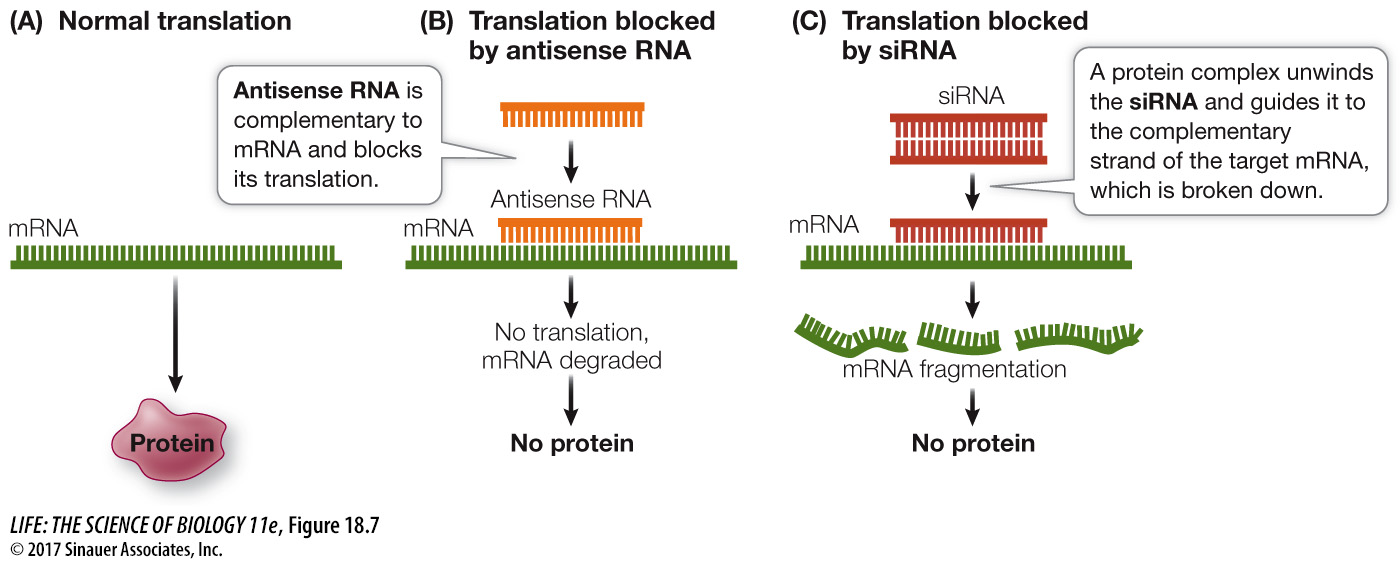Complementary RNA can prevent the expression of specific genes
Another way to study the expression of a specific gene is to knock it out by blocking the translation of its mRNA. The process developed for knocking out genes is yet another example of scientists imitating nature. As described in Key Concept 16.5, gene expression is sometimes regulated by the production of double-stranded RNA molecules that are processed to produce short, single-stranded microRNA (miRNA). These miRNAs are complementary to specific mRNA sequences (see Figure 16.18A), and when they bind to their target mRNAs, they inhibit translation. The hybrid mRNA molecules consisting of miRNA and the target mRNA tend to break down rapidly in the cytoplasm. Although the target gene continues to be transcribed, translation does not take place. Scientists have applied the idea of hybrid RNAs in developing methods for blocking the expression of particular genes (Figure 18.7). An organism can be transformed to produce mRNAs that are complementary to and thus bind to specific endogenous mRNAs, which prevents expression of the endogenous mRNA. Alternatively, cells can be injected with synthetic complementary sequences (see Figure 18.7B). The complementary single-stranded RNA sequence is called antisense RNA because it binds by base pairing to the “sense” bases on the mRNA.

Figure 18.7 Using Antisense RNA and siRNA to Block Translation of mRNA (A) Normally an mRNA is translated to produce a protein. Translation of a target mRNA can be prevented with (B) an antisense RNA or (C) a small interfering RNA (siRNA) that is complementary to the target mRNA.
Page 390
It may be possible to make antisense drugs to treat diseases that involve gene expression. For example, people with the genetic disease familial hypercholesterolemia are unable to break down cholesterol in the blood and accumulate fat deposits in blood vessels (as was the case with Janet whose story opened this chapter). Their excess cholesterol is transported in blood as part of a lipoprotein. Mipomersen is an antisense RNA directed against the translation of the mRNA for the “protein” part of this lipoprotein. When people with hypercholesterolemia take this drug, the level of the lipoprotein is reduced and so is the level of cholesterol in the bloodstream. Fat accumulation in blood vessels is lowered.
A technique related to antisense RNA takes advantage of RNA interference (RNAi), a natural mechanism for inhibiting mRNA translation that involves small interfering RNA (siRNA; see Figure 16.18B). siRNAs bind to complementary regions on their target mRNAs, which are then degraded. Since the discovery of RNAi in the late 1990s, scientists have synthesized artificial double-stranded siRNAs to inhibit the expression of known genes (see Figure 18.7C). Because these double-stranded siRNAs are more stable than antisense RNAs, the use of siRNAs is the preferred approach for blocking translation. An RNAi-based therapy has been developed to treat macular degeneration, an eye disease that results in near-blindness when blood vessels proliferate in the eye. The signaling molecule that stimulates vessel proliferation is a growth factor. An siRNA that targets this growth factor’s mRNA shows promise in stopping and even reversing the progress of the disease. Although medical applications for RNAi are mostly at the experimental stage, antisense RNA and RNAi have been widely used to test cause-and-effect relationships in biological research.
